Business Strategy: BIOMAS 5 Performance and Strategic Decisions
VerifiedAdded on 2023/01/18
|12
|3802
|78
AI Summary
This report provides insights into the projected performance of BIOMAS 5 and the key strategic decisions made during the Business Strategy Simulation Game. It covers topics such as the Y16 performance of BIOMAS 5, strategic concepts models and ideas, and the impact of different decisions on the business.
Contribute Materials
Your contribution can guide someone’s learning journey. Share your
documents today.
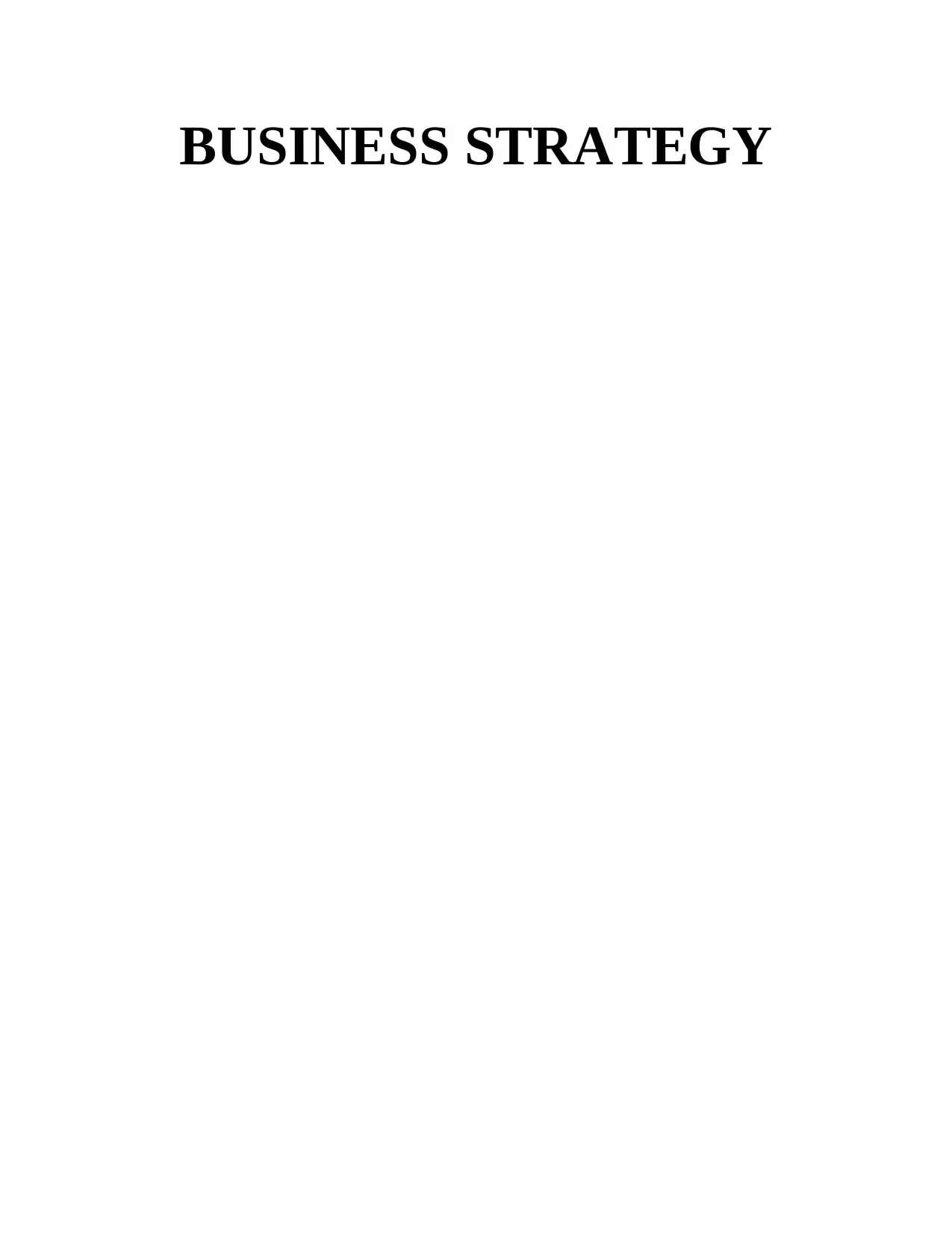
BUSINESS STRATEGY
Secure Best Marks with AI Grader
Need help grading? Try our AI Grader for instant feedback on your assignments.
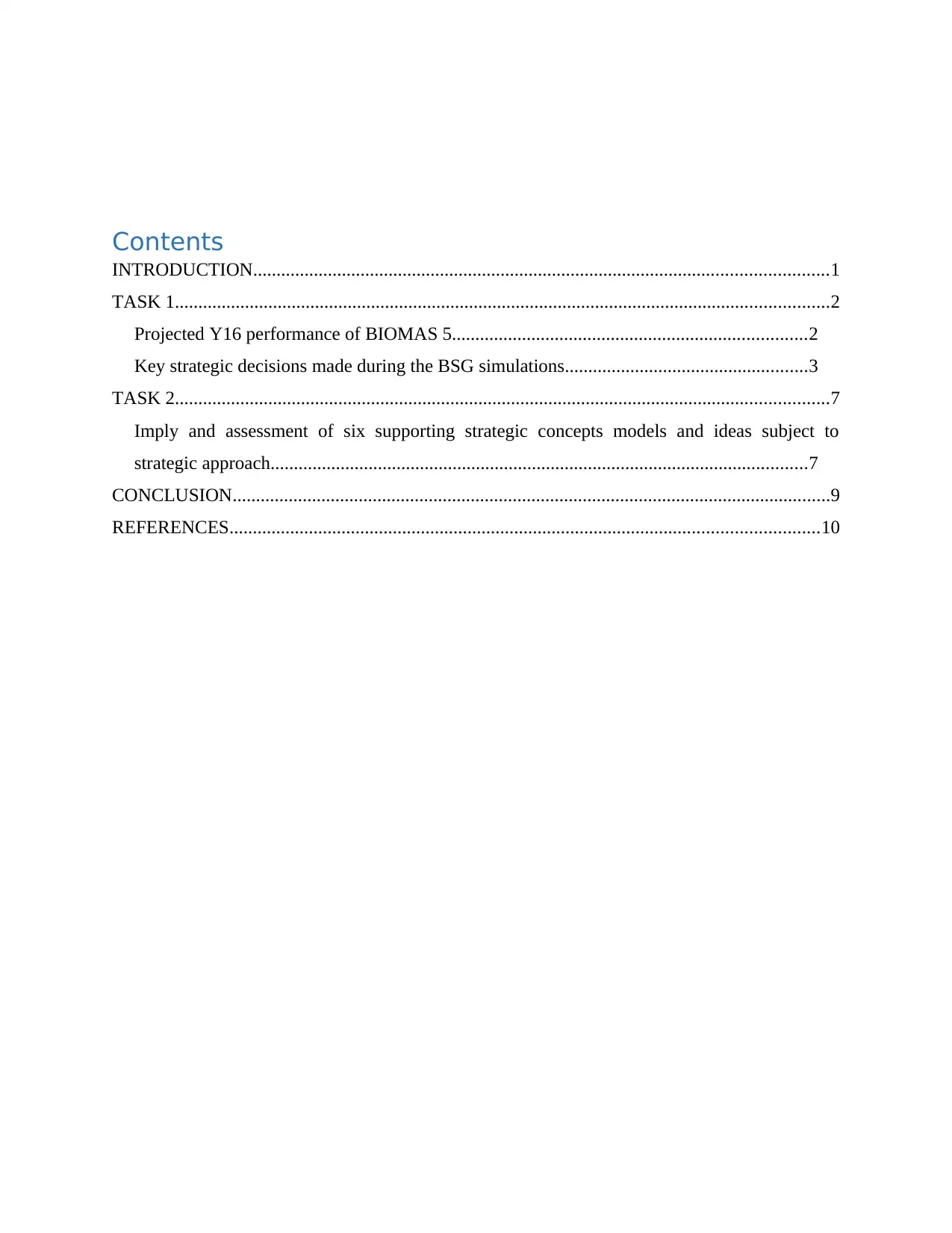
Contents
INTRODUCTION...........................................................................................................................1
TASK 1............................................................................................................................................2
Projected Y16 performance of BIOMAS 5............................................................................2
Key strategic decisions made during the BSG simulations....................................................3
TASK 2............................................................................................................................................7
Imply and assessment of six supporting strategic concepts models and ideas subject to
strategic approach...................................................................................................................7
CONCLUSION................................................................................................................................9
REFERENCES..............................................................................................................................10
INTRODUCTION...........................................................................................................................1
TASK 1............................................................................................................................................2
Projected Y16 performance of BIOMAS 5............................................................................2
Key strategic decisions made during the BSG simulations....................................................3
TASK 2............................................................................................................................................7
Imply and assessment of six supporting strategic concepts models and ideas subject to
strategic approach...................................................................................................................7
CONCLUSION................................................................................................................................9
REFERENCES..............................................................................................................................10
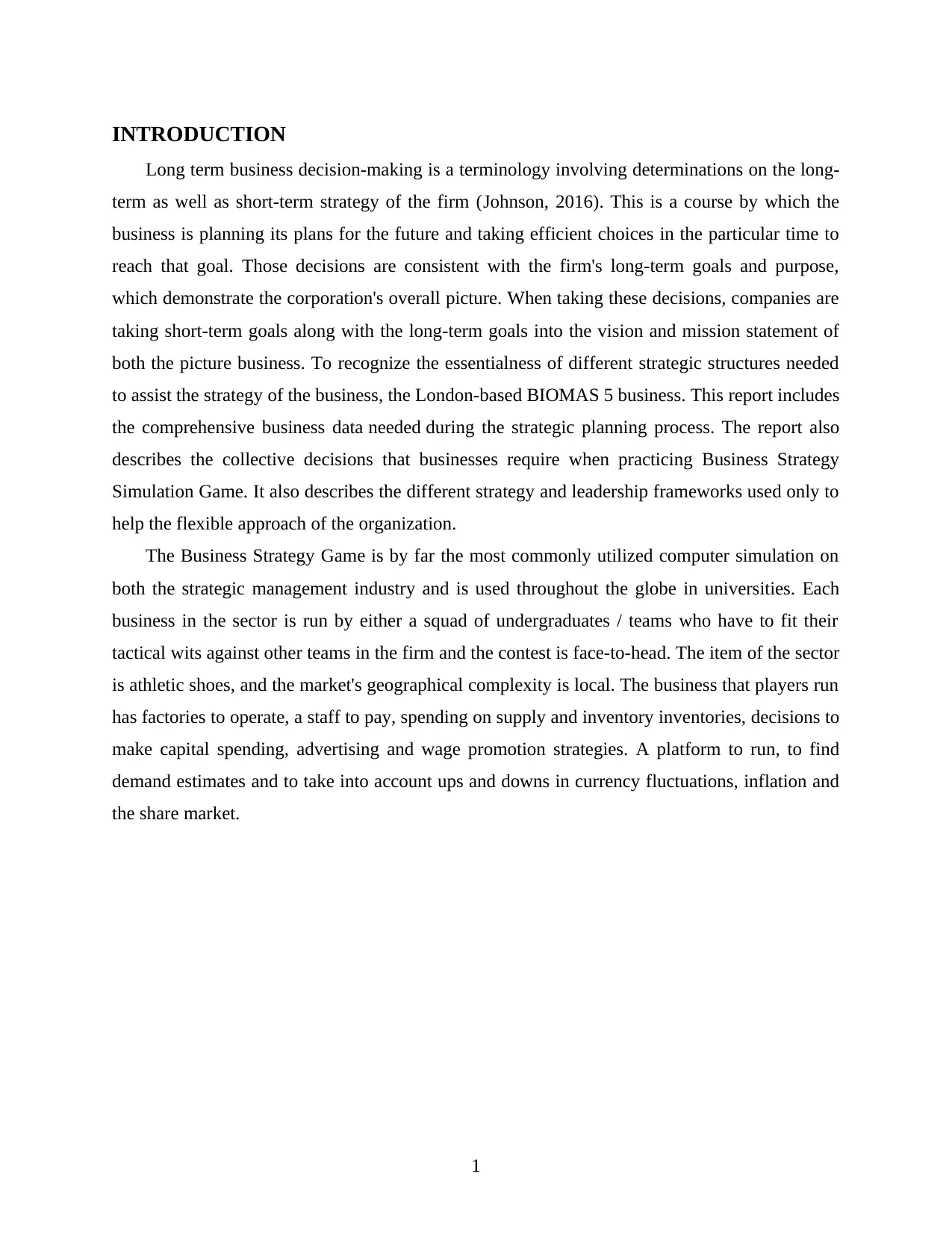
INTRODUCTION
Long term business decision-making is a terminology involving determinations on the long-
term as well as short-term strategy of the firm (Johnson, 2016). This is a course by which the
business is planning its plans for the future and taking efficient choices in the particular time to
reach that goal. Those decisions are consistent with the firm's long-term goals and purpose,
which demonstrate the corporation's overall picture. When taking these decisions, companies are
taking short-term goals along with the long-term goals into the vision and mission statement of
both the picture business. To recognize the essentialness of different strategic structures needed
to assist the strategy of the business, the London-based BIOMAS 5 business. This report includes
the comprehensive business data needed during the strategic planning process. The report also
describes the collective decisions that businesses require when practicing Business Strategy
Simulation Game. It also describes the different strategy and leadership frameworks used only to
help the flexible approach of the organization.
The Business Strategy Game is by far the most commonly utilized computer simulation on
both the strategic management industry and is used throughout the globe in universities. Each
business in the sector is run by either a squad of undergraduates / teams who have to fit their
tactical wits against other teams in the firm and the contest is face-to-head. The item of the sector
is athletic shoes, and the market's geographical complexity is local. The business that players run
has factories to operate, a staff to pay, spending on supply and inventory inventories, decisions to
make capital spending, advertising and wage promotion strategies. A platform to run, to find
demand estimates and to take into account ups and downs in currency fluctuations, inflation and
the share market.
1
Long term business decision-making is a terminology involving determinations on the long-
term as well as short-term strategy of the firm (Johnson, 2016). This is a course by which the
business is planning its plans for the future and taking efficient choices in the particular time to
reach that goal. Those decisions are consistent with the firm's long-term goals and purpose,
which demonstrate the corporation's overall picture. When taking these decisions, companies are
taking short-term goals along with the long-term goals into the vision and mission statement of
both the picture business. To recognize the essentialness of different strategic structures needed
to assist the strategy of the business, the London-based BIOMAS 5 business. This report includes
the comprehensive business data needed during the strategic planning process. The report also
describes the collective decisions that businesses require when practicing Business Strategy
Simulation Game. It also describes the different strategy and leadership frameworks used only to
help the flexible approach of the organization.
The Business Strategy Game is by far the most commonly utilized computer simulation on
both the strategic management industry and is used throughout the globe in universities. Each
business in the sector is run by either a squad of undergraduates / teams who have to fit their
tactical wits against other teams in the firm and the contest is face-to-head. The item of the sector
is athletic shoes, and the market's geographical complexity is local. The business that players run
has factories to operate, a staff to pay, spending on supply and inventory inventories, decisions to
make capital spending, advertising and wage promotion strategies. A platform to run, to find
demand estimates and to take into account ups and downs in currency fluctuations, inflation and
the share market.
1
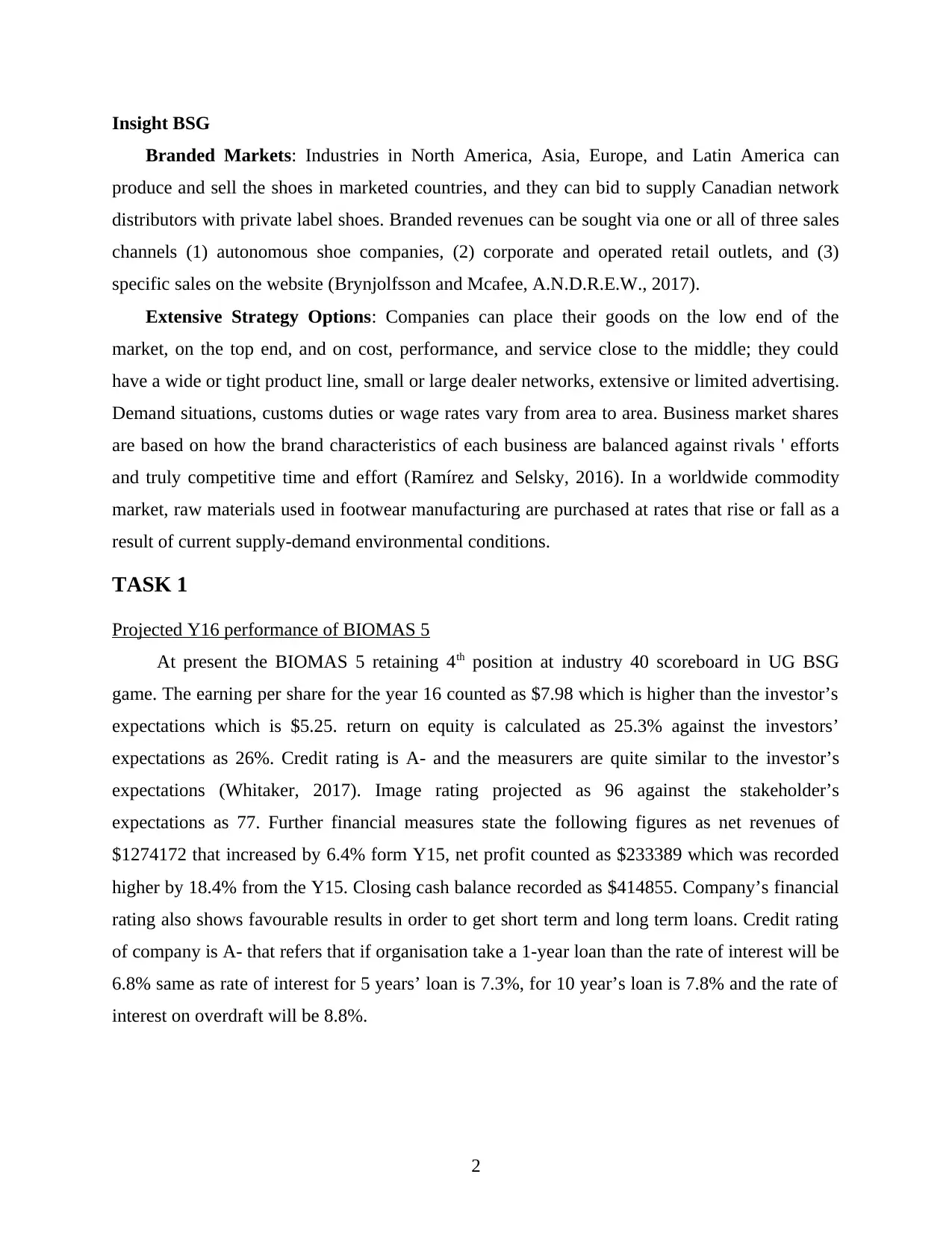
Insight BSG
Branded Markets: Industries in North America, Asia, Europe, and Latin America can
produce and sell the shoes in marketed countries, and they can bid to supply Canadian network
distributors with private label shoes. Branded revenues can be sought via one or all of three sales
channels (1) autonomous shoe companies, (2) corporate and operated retail outlets, and (3)
specific sales on the website (Brynjolfsson and Mcafee, A.N.D.R.E.W., 2017).
Extensive Strategy Options: Companies can place their goods on the low end of the
market, on the top end, and on cost, performance, and service close to the middle; they could
have a wide or tight product line, small or large dealer networks, extensive or limited advertising.
Demand situations, customs duties or wage rates vary from area to area. Business market shares
are based on how the brand characteristics of each business are balanced against rivals ' efforts
and truly competitive time and effort (Ramírez and Selsky, 2016). In a worldwide commodity
market, raw materials used in footwear manufacturing are purchased at rates that rise or fall as a
result of current supply-demand environmental conditions.
TASK 1
Projected Y16 performance of BIOMAS 5
At present the BIOMAS 5 retaining 4th position at industry 40 scoreboard in UG BSG
game. The earning per share for the year 16 counted as $7.98 which is higher than the investor’s
expectations which is $5.25. return on equity is calculated as 25.3% against the investors’
expectations as 26%. Credit rating is A- and the measurers are quite similar to the investor’s
expectations (Whitaker, 2017). Image rating projected as 96 against the stakeholder’s
expectations as 77. Further financial measures state the following figures as net revenues of
$1274172 that increased by 6.4% form Y15, net profit counted as $233389 which was recorded
higher by 18.4% from the Y15. Closing cash balance recorded as $414855. Company’s financial
rating also shows favourable results in order to get short term and long term loans. Credit rating
of company is A- that refers that if organisation take a 1-year loan than the rate of interest will be
6.8% same as rate of interest for 5 years’ loan is 7.3%, for 10 year’s loan is 7.8% and the rate of
interest on overdraft will be 8.8%.
2
Branded Markets: Industries in North America, Asia, Europe, and Latin America can
produce and sell the shoes in marketed countries, and they can bid to supply Canadian network
distributors with private label shoes. Branded revenues can be sought via one or all of three sales
channels (1) autonomous shoe companies, (2) corporate and operated retail outlets, and (3)
specific sales on the website (Brynjolfsson and Mcafee, A.N.D.R.E.W., 2017).
Extensive Strategy Options: Companies can place their goods on the low end of the
market, on the top end, and on cost, performance, and service close to the middle; they could
have a wide or tight product line, small or large dealer networks, extensive or limited advertising.
Demand situations, customs duties or wage rates vary from area to area. Business market shares
are based on how the brand characteristics of each business are balanced against rivals ' efforts
and truly competitive time and effort (Ramírez and Selsky, 2016). In a worldwide commodity
market, raw materials used in footwear manufacturing are purchased at rates that rise or fall as a
result of current supply-demand environmental conditions.
TASK 1
Projected Y16 performance of BIOMAS 5
At present the BIOMAS 5 retaining 4th position at industry 40 scoreboard in UG BSG
game. The earning per share for the year 16 counted as $7.98 which is higher than the investor’s
expectations which is $5.25. return on equity is calculated as 25.3% against the investors’
expectations as 26%. Credit rating is A- and the measurers are quite similar to the investor’s
expectations (Whitaker, 2017). Image rating projected as 96 against the stakeholder’s
expectations as 77. Further financial measures state the following figures as net revenues of
$1274172 that increased by 6.4% form Y15, net profit counted as $233389 which was recorded
higher by 18.4% from the Y15. Closing cash balance recorded as $414855. Company’s financial
rating also shows favourable results in order to get short term and long term loans. Credit rating
of company is A- that refers that if organisation take a 1-year loan than the rate of interest will be
6.8% same as rate of interest for 5 years’ loan is 7.3%, for 10 year’s loan is 7.8% and the rate of
interest on overdraft will be 8.8%.
2
Secure Best Marks with AI Grader
Need help grading? Try our AI Grader for instant feedback on your assignments.
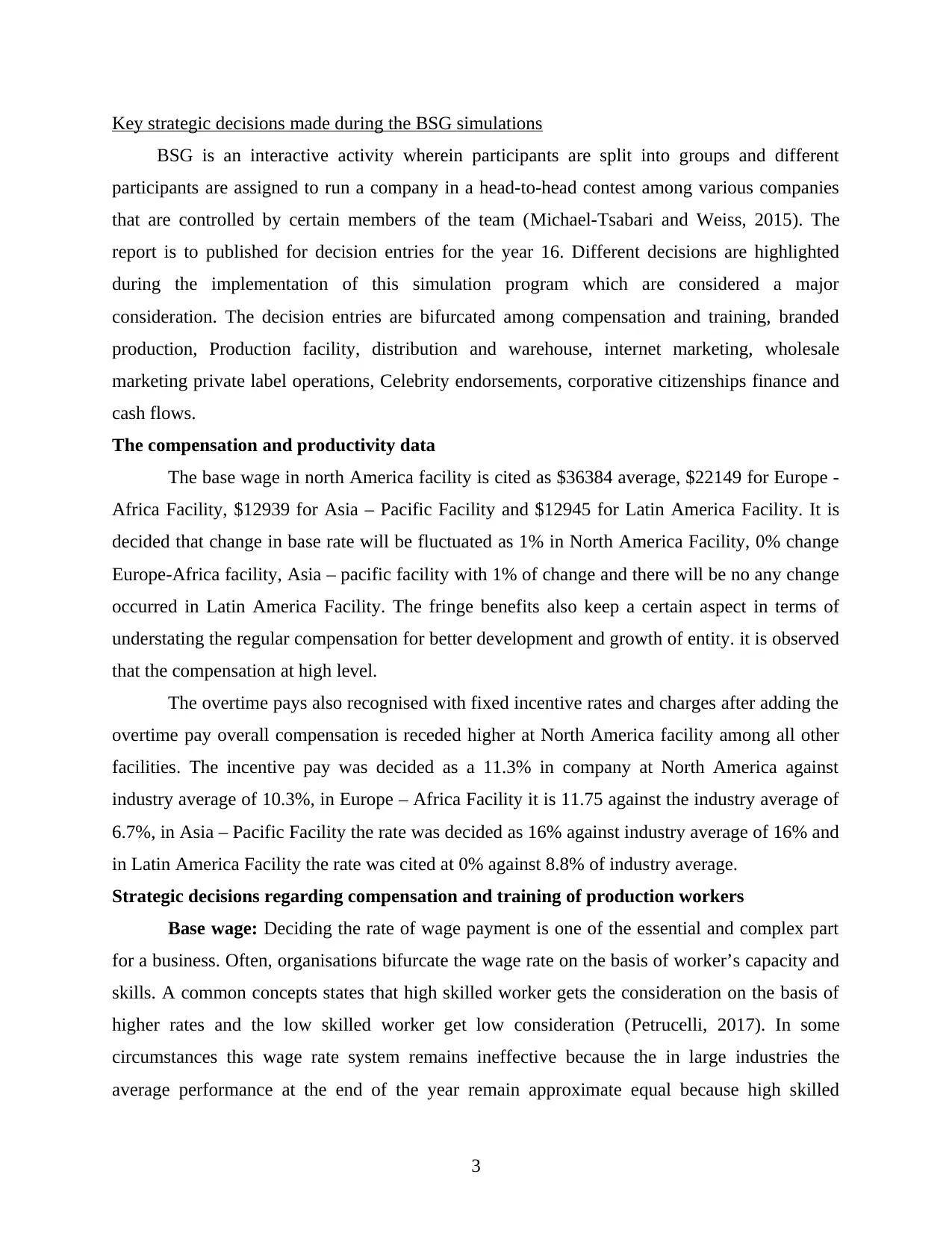
Key strategic decisions made during the BSG simulations
BSG is an interactive activity wherein participants are split into groups and different
participants are assigned to run a company in a head-to-head contest among various companies
that are controlled by certain members of the team (Michael-Tsabari and Weiss, 2015). The
report is to published for decision entries for the year 16. Different decisions are highlighted
during the implementation of this simulation program which are considered a major
consideration. The decision entries are bifurcated among compensation and training, branded
production, Production facility, distribution and warehouse, internet marketing, wholesale
marketing private label operations, Celebrity endorsements, corporative citizenships finance and
cash flows.
The compensation and productivity data
The base wage in north America facility is cited as $36384 average, $22149 for Europe -
Africa Facility, $12939 for Asia – Pacific Facility and $12945 for Latin America Facility. It is
decided that change in base rate will be fluctuated as 1% in North America Facility, 0% change
Europe-Africa facility, Asia – pacific facility with 1% of change and there will be no any change
occurred in Latin America Facility. The fringe benefits also keep a certain aspect in terms of
understating the regular compensation for better development and growth of entity. it is observed
that the compensation at high level.
The overtime pays also recognised with fixed incentive rates and charges after adding the
overtime pay overall compensation is receded higher at North America facility among all other
facilities. The incentive pay was decided as a 11.3% in company at North America against
industry average of 10.3%, in Europe – Africa Facility it is 11.75 against the industry average of
6.7%, in Asia – Pacific Facility the rate was decided as 16% against industry average of 16% and
in Latin America Facility the rate was cited at 0% against 8.8% of industry average.
Strategic decisions regarding compensation and training of production workers
Base wage: Deciding the rate of wage payment is one of the essential and complex part
for a business. Often, organisations bifurcate the wage rate on the basis of worker’s capacity and
skills. A common concepts states that high skilled worker gets the consideration on the basis of
higher rates and the low skilled worker get low consideration (Petrucelli, 2017). In some
circumstances this wage rate system remains ineffective because the in large industries the
average performance at the end of the year remain approximate equal because high skilled
3
BSG is an interactive activity wherein participants are split into groups and different
participants are assigned to run a company in a head-to-head contest among various companies
that are controlled by certain members of the team (Michael-Tsabari and Weiss, 2015). The
report is to published for decision entries for the year 16. Different decisions are highlighted
during the implementation of this simulation program which are considered a major
consideration. The decision entries are bifurcated among compensation and training, branded
production, Production facility, distribution and warehouse, internet marketing, wholesale
marketing private label operations, Celebrity endorsements, corporative citizenships finance and
cash flows.
The compensation and productivity data
The base wage in north America facility is cited as $36384 average, $22149 for Europe -
Africa Facility, $12939 for Asia – Pacific Facility and $12945 for Latin America Facility. It is
decided that change in base rate will be fluctuated as 1% in North America Facility, 0% change
Europe-Africa facility, Asia – pacific facility with 1% of change and there will be no any change
occurred in Latin America Facility. The fringe benefits also keep a certain aspect in terms of
understating the regular compensation for better development and growth of entity. it is observed
that the compensation at high level.
The overtime pays also recognised with fixed incentive rates and charges after adding the
overtime pay overall compensation is receded higher at North America facility among all other
facilities. The incentive pay was decided as a 11.3% in company at North America against
industry average of 10.3%, in Europe – Africa Facility it is 11.75 against the industry average of
6.7%, in Asia – Pacific Facility the rate was decided as 16% against industry average of 16% and
in Latin America Facility the rate was cited at 0% against 8.8% of industry average.
Strategic decisions regarding compensation and training of production workers
Base wage: Deciding the rate of wage payment is one of the essential and complex part
for a business. Often, organisations bifurcate the wage rate on the basis of worker’s capacity and
skills. A common concepts states that high skilled worker gets the consideration on the basis of
higher rates and the low skilled worker get low consideration (Petrucelli, 2017). In some
circumstances this wage rate system remains ineffective because the in large industries the
average performance at the end of the year remain approximate equal because high skilled
3
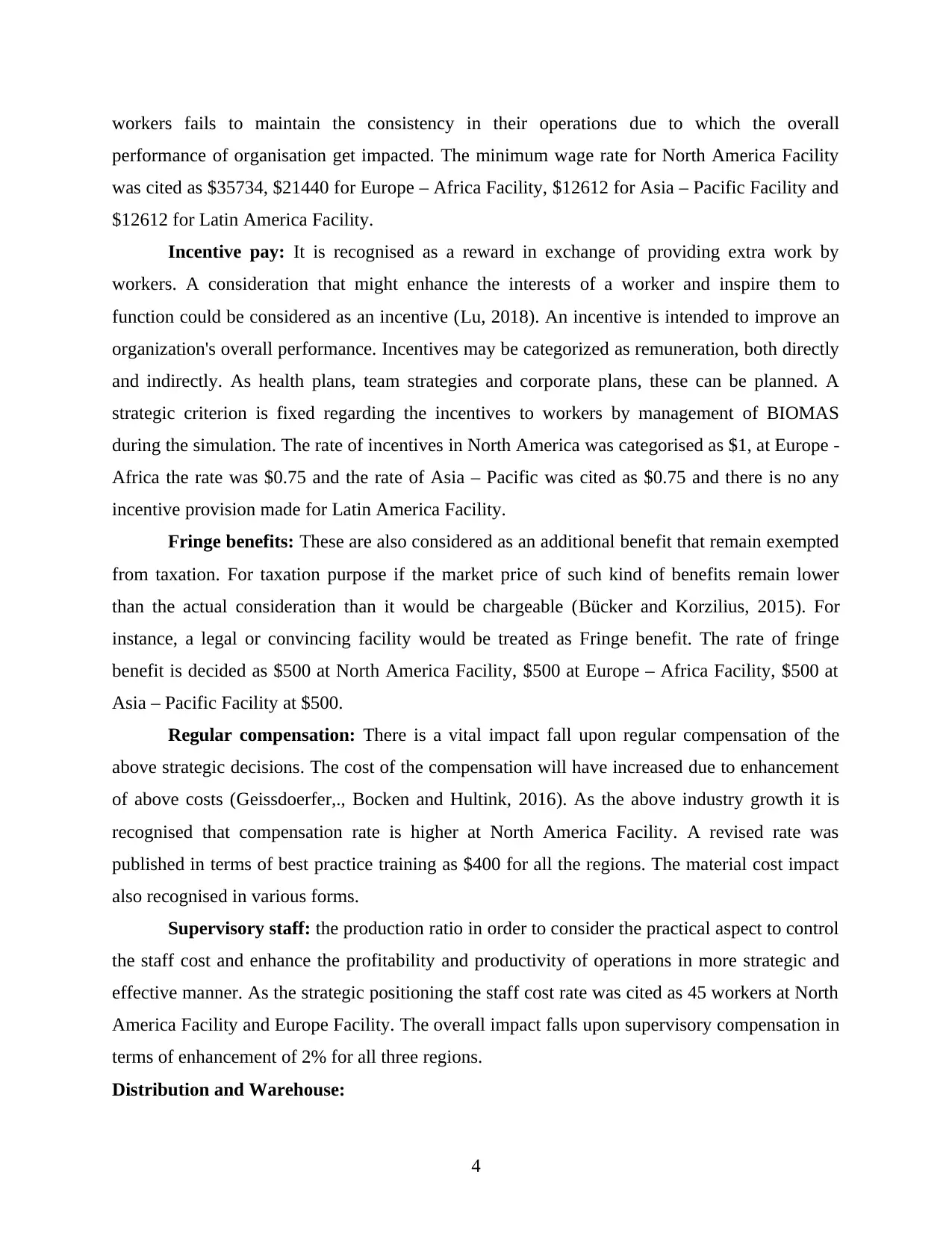
workers fails to maintain the consistency in their operations due to which the overall
performance of organisation get impacted. The minimum wage rate for North America Facility
was cited as $35734, $21440 for Europe – Africa Facility, $12612 for Asia – Pacific Facility and
$12612 for Latin America Facility.
Incentive pay: It is recognised as a reward in exchange of providing extra work by
workers. A consideration that might enhance the interests of a worker and inspire them to
function could be considered as an incentive (Lu, 2018). An incentive is intended to improve an
organization's overall performance. Incentives may be categorized as remuneration, both directly
and indirectly. As health plans, team strategies and corporate plans, these can be planned. A
strategic criterion is fixed regarding the incentives to workers by management of BIOMAS
during the simulation. The rate of incentives in North America was categorised as $1, at Europe -
Africa the rate was $0.75 and the rate of Asia – Pacific was cited as $0.75 and there is no any
incentive provision made for Latin America Facility.
Fringe benefits: These are also considered as an additional benefit that remain exempted
from taxation. For taxation purpose if the market price of such kind of benefits remain lower
than the actual consideration than it would be chargeable (Bücker and Korzilius, 2015). For
instance, a legal or convincing facility would be treated as Fringe benefit. The rate of fringe
benefit is decided as $500 at North America Facility, $500 at Europe – Africa Facility, $500 at
Asia – Pacific Facility at $500.
Regular compensation: There is a vital impact fall upon regular compensation of the
above strategic decisions. The cost of the compensation will have increased due to enhancement
of above costs (Geissdoerfer,., Bocken and Hultink, 2016). As the above industry growth it is
recognised that compensation rate is higher at North America Facility. A revised rate was
published in terms of best practice training as $400 for all the regions. The material cost impact
also recognised in various forms.
Supervisory staff: the production ratio in order to consider the practical aspect to control
the staff cost and enhance the profitability and productivity of operations in more strategic and
effective manner. As the strategic positioning the staff cost rate was cited as 45 workers at North
America Facility and Europe Facility. The overall impact falls upon supervisory compensation in
terms of enhancement of 2% for all three regions.
Distribution and Warehouse:
4
performance of organisation get impacted. The minimum wage rate for North America Facility
was cited as $35734, $21440 for Europe – Africa Facility, $12612 for Asia – Pacific Facility and
$12612 for Latin America Facility.
Incentive pay: It is recognised as a reward in exchange of providing extra work by
workers. A consideration that might enhance the interests of a worker and inspire them to
function could be considered as an incentive (Lu, 2018). An incentive is intended to improve an
organization's overall performance. Incentives may be categorized as remuneration, both directly
and indirectly. As health plans, team strategies and corporate plans, these can be planned. A
strategic criterion is fixed regarding the incentives to workers by management of BIOMAS
during the simulation. The rate of incentives in North America was categorised as $1, at Europe -
Africa the rate was $0.75 and the rate of Asia – Pacific was cited as $0.75 and there is no any
incentive provision made for Latin America Facility.
Fringe benefits: These are also considered as an additional benefit that remain exempted
from taxation. For taxation purpose if the market price of such kind of benefits remain lower
than the actual consideration than it would be chargeable (Bücker and Korzilius, 2015). For
instance, a legal or convincing facility would be treated as Fringe benefit. The rate of fringe
benefit is decided as $500 at North America Facility, $500 at Europe – Africa Facility, $500 at
Asia – Pacific Facility at $500.
Regular compensation: There is a vital impact fall upon regular compensation of the
above strategic decisions. The cost of the compensation will have increased due to enhancement
of above costs (Geissdoerfer,., Bocken and Hultink, 2016). As the above industry growth it is
recognised that compensation rate is higher at North America Facility. A revised rate was
published in terms of best practice training as $400 for all the regions. The material cost impact
also recognised in various forms.
Supervisory staff: the production ratio in order to consider the practical aspect to control
the staff cost and enhance the profitability and productivity of operations in more strategic and
effective manner. As the strategic positioning the staff cost rate was cited as 45 workers at North
America Facility and Europe Facility. The overall impact falls upon supervisory compensation in
terms of enhancement of 2% for all three regions.
Distribution and Warehouse:
4
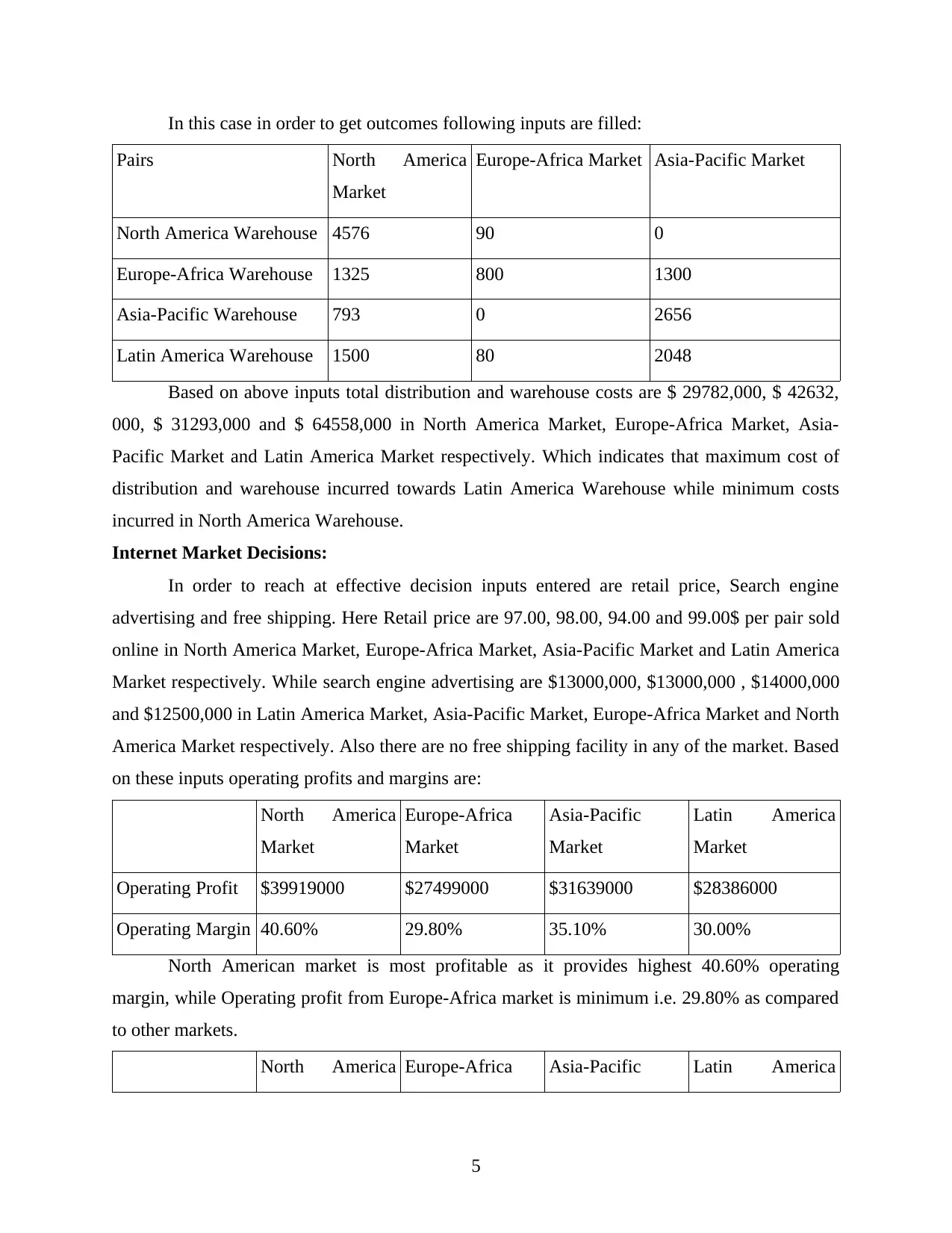
In this case in order to get outcomes following inputs are filled:
Pairs North America
Market
Europe-Africa Market Asia-Pacific Market
North America Warehouse 4576 90 0
Europe-Africa Warehouse 1325 800 1300
Asia-Pacific Warehouse 793 0 2656
Latin America Warehouse 1500 80 2048
Based on above inputs total distribution and warehouse costs are $ 29782,000, $ 42632,
000, $ 31293,000 and $ 64558,000 in North America Market, Europe-Africa Market, Asia-
Pacific Market and Latin America Market respectively. Which indicates that maximum cost of
distribution and warehouse incurred towards Latin America Warehouse while minimum costs
incurred in North America Warehouse.
Internet Market Decisions:
In order to reach at effective decision inputs entered are retail price, Search engine
advertising and free shipping. Here Retail price are 97.00, 98.00, 94.00 and 99.00$ per pair sold
online in North America Market, Europe-Africa Market, Asia-Pacific Market and Latin America
Market respectively. While search engine advertising are $13000,000, $13000,000 , $14000,000
and $12500,000 in Latin America Market, Asia-Pacific Market, Europe-Africa Market and North
America Market respectively. Also there are no free shipping facility in any of the market. Based
on these inputs operating profits and margins are:
North America
Market
Europe-Africa
Market
Asia-Pacific
Market
Latin America
Market
Operating Profit $39919000 $27499000 $31639000 $28386000
Operating Margin 40.60% 29.80% 35.10% 30.00%
North American market is most profitable as it provides highest 40.60% operating
margin, while Operating profit from Europe-Africa market is minimum i.e. 29.80% as compared
to other markets.
North America Europe-Africa Asia-Pacific Latin America
5
Pairs North America
Market
Europe-Africa Market Asia-Pacific Market
North America Warehouse 4576 90 0
Europe-Africa Warehouse 1325 800 1300
Asia-Pacific Warehouse 793 0 2656
Latin America Warehouse 1500 80 2048
Based on above inputs total distribution and warehouse costs are $ 29782,000, $ 42632,
000, $ 31293,000 and $ 64558,000 in North America Market, Europe-Africa Market, Asia-
Pacific Market and Latin America Market respectively. Which indicates that maximum cost of
distribution and warehouse incurred towards Latin America Warehouse while minimum costs
incurred in North America Warehouse.
Internet Market Decisions:
In order to reach at effective decision inputs entered are retail price, Search engine
advertising and free shipping. Here Retail price are 97.00, 98.00, 94.00 and 99.00$ per pair sold
online in North America Market, Europe-Africa Market, Asia-Pacific Market and Latin America
Market respectively. While search engine advertising are $13000,000, $13000,000 , $14000,000
and $12500,000 in Latin America Market, Asia-Pacific Market, Europe-Africa Market and North
America Market respectively. Also there are no free shipping facility in any of the market. Based
on these inputs operating profits and margins are:
North America
Market
Europe-Africa
Market
Asia-Pacific
Market
Latin America
Market
Operating Profit $39919000 $27499000 $31639000 $28386000
Operating Margin 40.60% 29.80% 35.10% 30.00%
North American market is most profitable as it provides highest 40.60% operating
margin, while Operating profit from Europe-Africa market is minimum i.e. 29.80% as compared
to other markets.
North America Europe-Africa Asia-Pacific Latin America
5
Paraphrase This Document
Need a fresh take? Get an instant paraphrase of this document with our AI Paraphraser
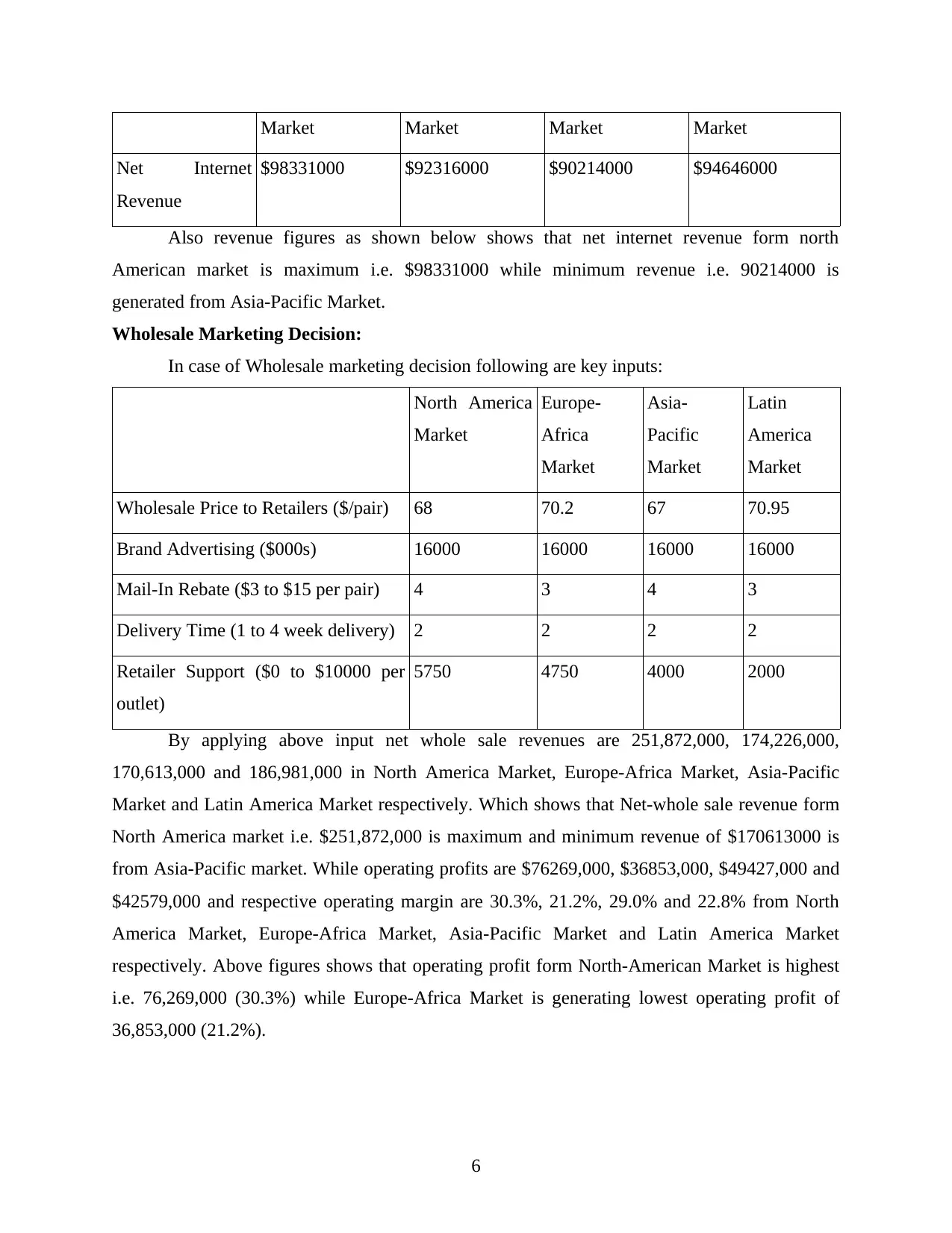
Market Market Market Market
Net Internet
Revenue
$98331000 $92316000 $90214000 $94646000
Also revenue figures as shown below shows that net internet revenue form north
American market is maximum i.e. $98331000 while minimum revenue i.e. 90214000 is
generated from Asia-Pacific Market.
Wholesale Marketing Decision:
In case of Wholesale marketing decision following are key inputs:
North America
Market
Europe-
Africa
Market
Asia-
Pacific
Market
Latin
America
Market
Wholesale Price to Retailers ($/pair) 68 70.2 67 70.95
Brand Advertising ($000s) 16000 16000 16000 16000
Mail-In Rebate ($3 to $15 per pair) 4 3 4 3
Delivery Time (1 to 4 week delivery) 2 2 2 2
Retailer Support ($0 to $10000 per
outlet)
5750 4750 4000 2000
By applying above input net whole sale revenues are 251,872,000, 174,226,000,
170,613,000 and 186,981,000 in North America Market, Europe-Africa Market, Asia-Pacific
Market and Latin America Market respectively. Which shows that Net-whole sale revenue form
North America market i.e. $251,872,000 is maximum and minimum revenue of $170613000 is
from Asia-Pacific market. While operating profits are $76269,000, $36853,000, $49427,000 and
$42579,000 and respective operating margin are 30.3%, 21.2%, 29.0% and 22.8% from North
America Market, Europe-Africa Market, Asia-Pacific Market and Latin America Market
respectively. Above figures shows that operating profit form North-American Market is highest
i.e. 76,269,000 (30.3%) while Europe-Africa Market is generating lowest operating profit of
36,853,000 (21.2%).
6
Net Internet
Revenue
$98331000 $92316000 $90214000 $94646000
Also revenue figures as shown below shows that net internet revenue form north
American market is maximum i.e. $98331000 while minimum revenue i.e. 90214000 is
generated from Asia-Pacific Market.
Wholesale Marketing Decision:
In case of Wholesale marketing decision following are key inputs:
North America
Market
Europe-
Africa
Market
Asia-
Pacific
Market
Latin
America
Market
Wholesale Price to Retailers ($/pair) 68 70.2 67 70.95
Brand Advertising ($000s) 16000 16000 16000 16000
Mail-In Rebate ($3 to $15 per pair) 4 3 4 3
Delivery Time (1 to 4 week delivery) 2 2 2 2
Retailer Support ($0 to $10000 per
outlet)
5750 4750 4000 2000
By applying above input net whole sale revenues are 251,872,000, 174,226,000,
170,613,000 and 186,981,000 in North America Market, Europe-Africa Market, Asia-Pacific
Market and Latin America Market respectively. Which shows that Net-whole sale revenue form
North America market i.e. $251,872,000 is maximum and minimum revenue of $170613000 is
from Asia-Pacific market. While operating profits are $76269,000, $36853,000, $49427,000 and
$42579,000 and respective operating margin are 30.3%, 21.2%, 29.0% and 22.8% from North
America Market, Europe-Africa Market, Asia-Pacific Market and Latin America Market
respectively. Above figures shows that operating profit form North-American Market is highest
i.e. 76,269,000 (30.3%) while Europe-Africa Market is generating lowest operating profit of
36,853,000 (21.2%).
6
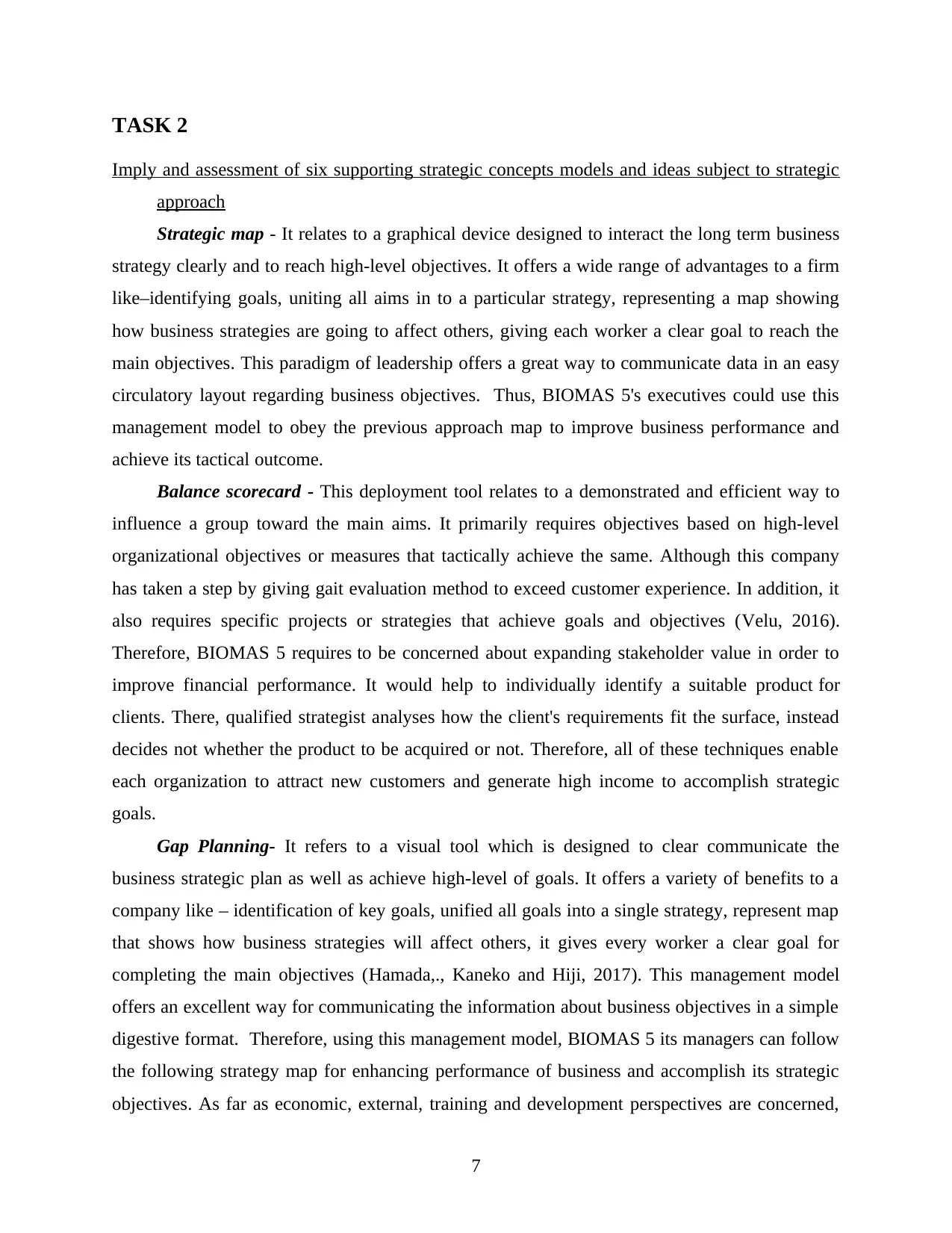
TASK 2
Imply and assessment of six supporting strategic concepts models and ideas subject to strategic
approach
Strategic map - It relates to a graphical device designed to interact the long term business
strategy clearly and to reach high-level objectives. It offers a wide range of advantages to a firm
like–identifying goals, uniting all aims in to a particular strategy, representing a map showing
how business strategies are going to affect others, giving each worker a clear goal to reach the
main objectives. This paradigm of leadership offers a great way to communicate data in an easy
circulatory layout regarding business objectives. Thus, BIOMAS 5's executives could use this
management model to obey the previous approach map to improve business performance and
achieve its tactical outcome.
Balance scorecard - This deployment tool relates to a demonstrated and efficient way to
influence a group toward the main aims. It primarily requires objectives based on high-level
organizational objectives or measures that tactically achieve the same. Although this company
has taken a step by giving gait evaluation method to exceed customer experience. In addition, it
also requires specific projects or strategies that achieve goals and objectives (Velu, 2016).
Therefore, BIOMAS 5 requires to be concerned about expanding stakeholder value in order to
improve financial performance. It would help to individually identify a suitable product for
clients. There, qualified strategist analyses how the client's requirements fit the surface, instead
decides not whether the product to be acquired or not. Therefore, all of these techniques enable
each organization to attract new customers and generate high income to accomplish strategic
goals.
Gap Planning- It refers to a visual tool which is designed to clear communicate the
business strategic plan as well as achieve high-level of goals. It offers a variety of benefits to a
company like – identification of key goals, unified all goals into a single strategy, represent map
that shows how business strategies will affect others, it gives every worker a clear goal for
completing the main objectives (Hamada,., Kaneko and Hiji, 2017). This management model
offers an excellent way for communicating the information about business objectives in a simple
digestive format. Therefore, using this management model, BIOMAS 5 its managers can follow
the following strategy map for enhancing performance of business and accomplish its strategic
objectives. As far as economic, external, training and development perspectives are concerned,
7
Imply and assessment of six supporting strategic concepts models and ideas subject to strategic
approach
Strategic map - It relates to a graphical device designed to interact the long term business
strategy clearly and to reach high-level objectives. It offers a wide range of advantages to a firm
like–identifying goals, uniting all aims in to a particular strategy, representing a map showing
how business strategies are going to affect others, giving each worker a clear goal to reach the
main objectives. This paradigm of leadership offers a great way to communicate data in an easy
circulatory layout regarding business objectives. Thus, BIOMAS 5's executives could use this
management model to obey the previous approach map to improve business performance and
achieve its tactical outcome.
Balance scorecard - This deployment tool relates to a demonstrated and efficient way to
influence a group toward the main aims. It primarily requires objectives based on high-level
organizational objectives or measures that tactically achieve the same. Although this company
has taken a step by giving gait evaluation method to exceed customer experience. In addition, it
also requires specific projects or strategies that achieve goals and objectives (Velu, 2016).
Therefore, BIOMAS 5 requires to be concerned about expanding stakeholder value in order to
improve financial performance. It would help to individually identify a suitable product for
clients. There, qualified strategist analyses how the client's requirements fit the surface, instead
decides not whether the product to be acquired or not. Therefore, all of these techniques enable
each organization to attract new customers and generate high income to accomplish strategic
goals.
Gap Planning- It refers to a visual tool which is designed to clear communicate the
business strategic plan as well as achieve high-level of goals. It offers a variety of benefits to a
company like – identification of key goals, unified all goals into a single strategy, represent map
that shows how business strategies will affect others, it gives every worker a clear goal for
completing the main objectives (Hamada,., Kaneko and Hiji, 2017). This management model
offers an excellent way for communicating the information about business objectives in a simple
digestive format. Therefore, using this management model, BIOMAS 5 its managers can follow
the following strategy map for enhancing performance of business and accomplish its strategic
objectives. As far as economic, external, training and development perspectives are concerned,
7
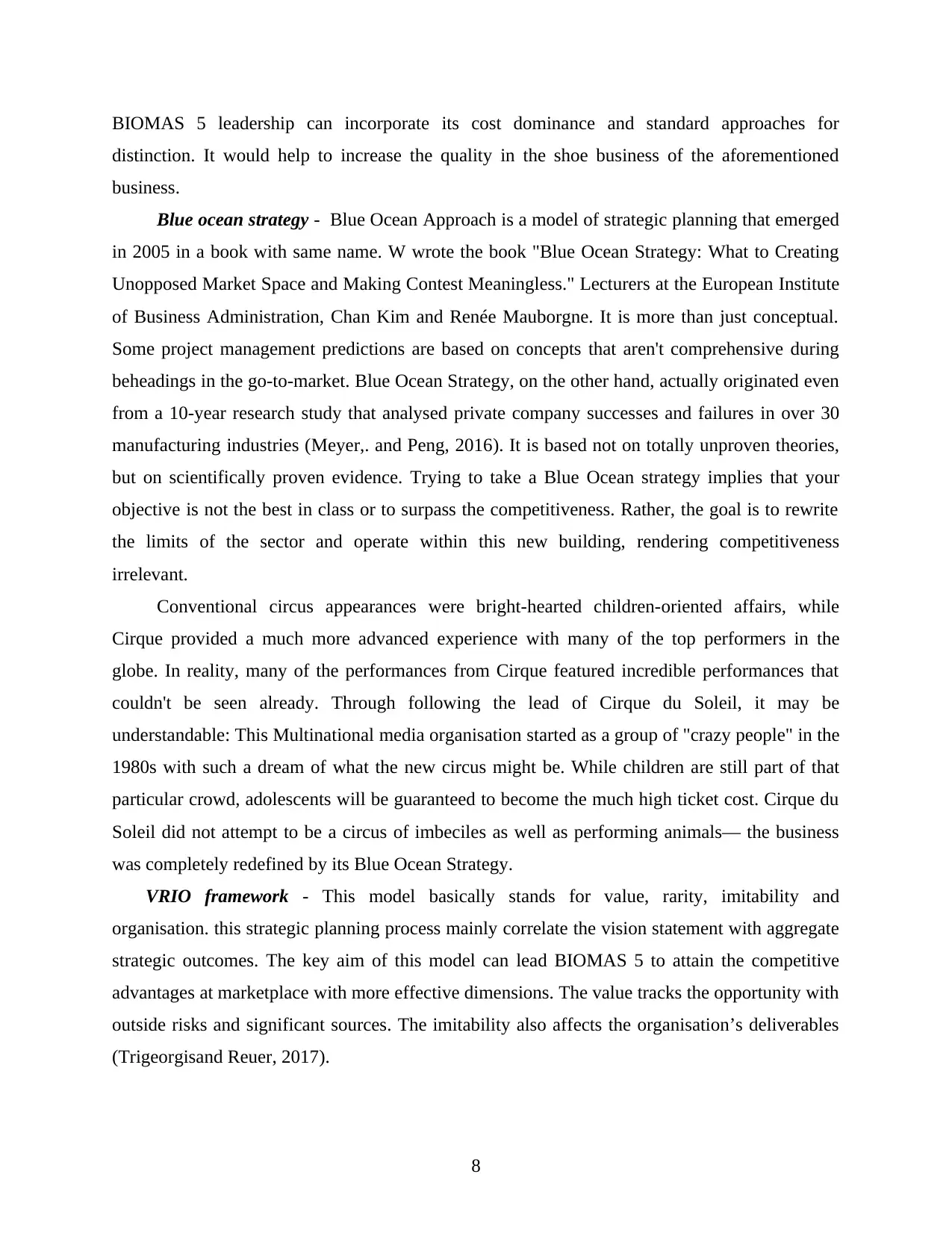
BIOMAS 5 leadership can incorporate its cost dominance and standard approaches for
distinction. It would help to increase the quality in the shoe business of the aforementioned
business.
Blue ocean strategy - Blue Ocean Approach is a model of strategic planning that emerged
in 2005 in a book with same name. W wrote the book "Blue Ocean Strategy: What to Creating
Unopposed Market Space and Making Contest Meaningless." Lecturers at the European Institute
of Business Administration, Chan Kim and Renée Mauborgne. It is more than just conceptual.
Some project management predictions are based on concepts that aren't comprehensive during
beheadings in the go-to-market. Blue Ocean Strategy, on the other hand, actually originated even
from a 10-year research study that analysed private company successes and failures in over 30
manufacturing industries (Meyer,. and Peng, 2016). It is based not on totally unproven theories,
but on scientifically proven evidence. Trying to take a Blue Ocean strategy implies that your
objective is not the best in class or to surpass the competitiveness. Rather, the goal is to rewrite
the limits of the sector and operate within this new building, rendering competitiveness
irrelevant.
Conventional circus appearances were bright-hearted children-oriented affairs, while
Cirque provided a much more advanced experience with many of the top performers in the
globe. In reality, many of the performances from Cirque featured incredible performances that
couldn't be seen already. Through following the lead of Cirque du Soleil, it may be
understandable: This Multinational media organisation started as a group of "crazy people" in the
1980s with such a dream of what the new circus might be. While children are still part of that
particular crowd, adolescents will be guaranteed to become the much high ticket cost. Cirque du
Soleil did not attempt to be a circus of imbeciles as well as performing animals— the business
was completely redefined by its Blue Ocean Strategy.
VRIO framework - This model basically stands for value, rarity, imitability and
organisation. this strategic planning process mainly correlate the vision statement with aggregate
strategic outcomes. The key aim of this model can lead BIOMAS 5 to attain the competitive
advantages at marketplace with more effective dimensions. The value tracks the opportunity with
outside risks and significant sources. The imitability also affects the organisation’s deliverables
(Trigeorgisand Reuer, 2017).
8
distinction. It would help to increase the quality in the shoe business of the aforementioned
business.
Blue ocean strategy - Blue Ocean Approach is a model of strategic planning that emerged
in 2005 in a book with same name. W wrote the book "Blue Ocean Strategy: What to Creating
Unopposed Market Space and Making Contest Meaningless." Lecturers at the European Institute
of Business Administration, Chan Kim and Renée Mauborgne. It is more than just conceptual.
Some project management predictions are based on concepts that aren't comprehensive during
beheadings in the go-to-market. Blue Ocean Strategy, on the other hand, actually originated even
from a 10-year research study that analysed private company successes and failures in over 30
manufacturing industries (Meyer,. and Peng, 2016). It is based not on totally unproven theories,
but on scientifically proven evidence. Trying to take a Blue Ocean strategy implies that your
objective is not the best in class or to surpass the competitiveness. Rather, the goal is to rewrite
the limits of the sector and operate within this new building, rendering competitiveness
irrelevant.
Conventional circus appearances were bright-hearted children-oriented affairs, while
Cirque provided a much more advanced experience with many of the top performers in the
globe. In reality, many of the performances from Cirque featured incredible performances that
couldn't be seen already. Through following the lead of Cirque du Soleil, it may be
understandable: This Multinational media organisation started as a group of "crazy people" in the
1980s with such a dream of what the new circus might be. While children are still part of that
particular crowd, adolescents will be guaranteed to become the much high ticket cost. Cirque du
Soleil did not attempt to be a circus of imbeciles as well as performing animals— the business
was completely redefined by its Blue Ocean Strategy.
VRIO framework - This model basically stands for value, rarity, imitability and
organisation. this strategic planning process mainly correlate the vision statement with aggregate
strategic outcomes. The key aim of this model can lead BIOMAS 5 to attain the competitive
advantages at marketplace with more effective dimensions. The value tracks the opportunity with
outside risks and significant sources. The imitability also affects the organisation’s deliverables
(Trigeorgisand Reuer, 2017).
8
Secure Best Marks with AI Grader
Need help grading? Try our AI Grader for instant feedback on your assignments.
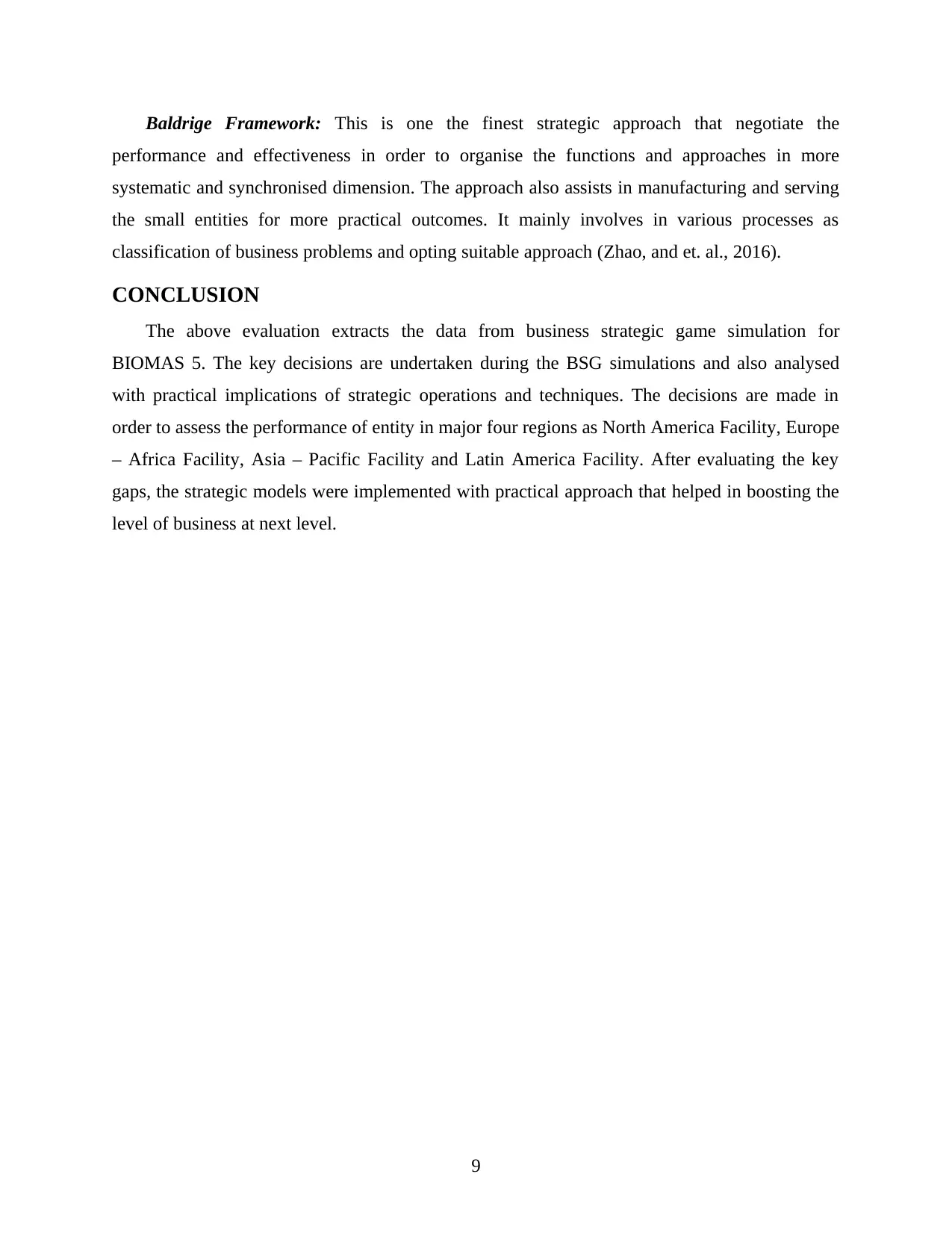
Baldrige Framework: This is one the finest strategic approach that negotiate the
performance and effectiveness in order to organise the functions and approaches in more
systematic and synchronised dimension. The approach also assists in manufacturing and serving
the small entities for more practical outcomes. It mainly involves in various processes as
classification of business problems and opting suitable approach (Zhao, and et. al., 2016).
CONCLUSION
The above evaluation extracts the data from business strategic game simulation for
BIOMAS 5. The key decisions are undertaken during the BSG simulations and also analysed
with practical implications of strategic operations and techniques. The decisions are made in
order to assess the performance of entity in major four regions as North America Facility, Europe
– Africa Facility, Asia – Pacific Facility and Latin America Facility. After evaluating the key
gaps, the strategic models were implemented with practical approach that helped in boosting the
level of business at next level.
9
performance and effectiveness in order to organise the functions and approaches in more
systematic and synchronised dimension. The approach also assists in manufacturing and serving
the small entities for more practical outcomes. It mainly involves in various processes as
classification of business problems and opting suitable approach (Zhao, and et. al., 2016).
CONCLUSION
The above evaluation extracts the data from business strategic game simulation for
BIOMAS 5. The key decisions are undertaken during the BSG simulations and also analysed
with practical implications of strategic operations and techniques. The decisions are made in
order to assess the performance of entity in major four regions as North America Facility, Europe
– Africa Facility, Asia – Pacific Facility and Latin America Facility. After evaluating the key
gaps, the strategic models were implemented with practical approach that helped in boosting the
level of business at next level.
9
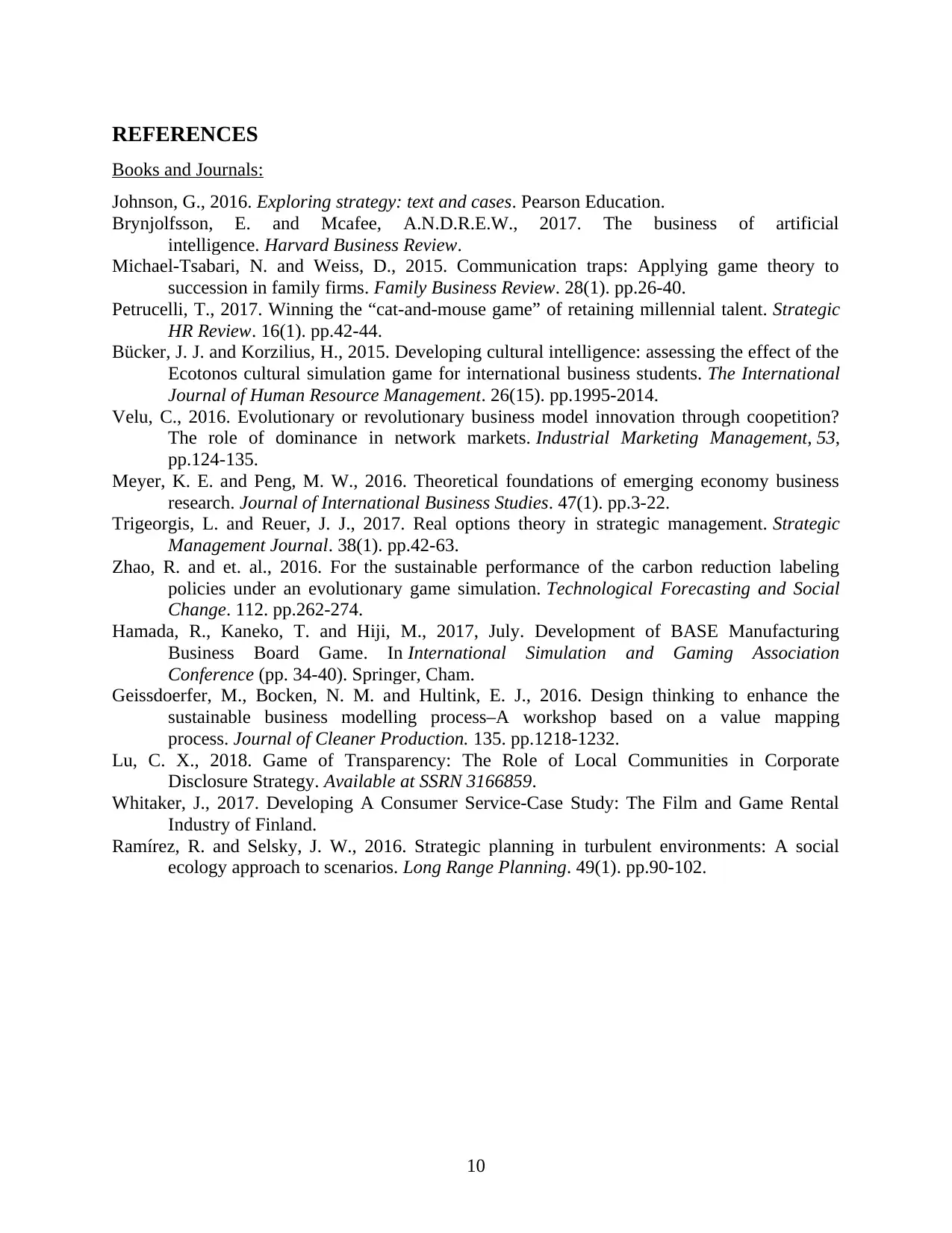
REFERENCES
Books and Journals:
Johnson, G., 2016. Exploring strategy: text and cases. Pearson Education.
Brynjolfsson, E. and Mcafee, A.N.D.R.E.W., 2017. The business of artificial
intelligence. Harvard Business Review.
Michael-Tsabari, N. and Weiss, D., 2015. Communication traps: Applying game theory to
succession in family firms. Family Business Review. 28(1). pp.26-40.
Petrucelli, T., 2017. Winning the “cat-and-mouse game” of retaining millennial talent. Strategic
HR Review. 16(1). pp.42-44.
Bücker, J. J. and Korzilius, H., 2015. Developing cultural intelligence: assessing the effect of the
Ecotonos cultural simulation game for international business students. The International
Journal of Human Resource Management. 26(15). pp.1995-2014.
Velu, C., 2016. Evolutionary or revolutionary business model innovation through coopetition?
The role of dominance in network markets. Industrial Marketing Management, 53,
pp.124-135.
Meyer, K. E. and Peng, M. W., 2016. Theoretical foundations of emerging economy business
research. Journal of International Business Studies. 47(1). pp.3-22.
Trigeorgis, L. and Reuer, J. J., 2017. Real options theory in strategic management. Strategic
Management Journal. 38(1). pp.42-63.
Zhao, R. and et. al., 2016. For the sustainable performance of the carbon reduction labeling
policies under an evolutionary game simulation. Technological Forecasting and Social
Change. 112. pp.262-274.
Hamada, R., Kaneko, T. and Hiji, M., 2017, July. Development of BASE Manufacturing
Business Board Game. In International Simulation and Gaming Association
Conference (pp. 34-40). Springer, Cham.
Geissdoerfer, M., Bocken, N. M. and Hultink, E. J., 2016. Design thinking to enhance the
sustainable business modelling process–A workshop based on a value mapping
process. Journal of Cleaner Production. 135. pp.1218-1232.
Lu, C. X., 2018. Game of Transparency: The Role of Local Communities in Corporate
Disclosure Strategy. Available at SSRN 3166859.
Whitaker, J., 2017. Developing A Consumer Service-Case Study: The Film and Game Rental
Industry of Finland.
Ramírez, R. and Selsky, J. W., 2016. Strategic planning in turbulent environments: A social
ecology approach to scenarios. Long Range Planning. 49(1). pp.90-102.
10
Books and Journals:
Johnson, G., 2016. Exploring strategy: text and cases. Pearson Education.
Brynjolfsson, E. and Mcafee, A.N.D.R.E.W., 2017. The business of artificial
intelligence. Harvard Business Review.
Michael-Tsabari, N. and Weiss, D., 2015. Communication traps: Applying game theory to
succession in family firms. Family Business Review. 28(1). pp.26-40.
Petrucelli, T., 2017. Winning the “cat-and-mouse game” of retaining millennial talent. Strategic
HR Review. 16(1). pp.42-44.
Bücker, J. J. and Korzilius, H., 2015. Developing cultural intelligence: assessing the effect of the
Ecotonos cultural simulation game for international business students. The International
Journal of Human Resource Management. 26(15). pp.1995-2014.
Velu, C., 2016. Evolutionary or revolutionary business model innovation through coopetition?
The role of dominance in network markets. Industrial Marketing Management, 53,
pp.124-135.
Meyer, K. E. and Peng, M. W., 2016. Theoretical foundations of emerging economy business
research. Journal of International Business Studies. 47(1). pp.3-22.
Trigeorgis, L. and Reuer, J. J., 2017. Real options theory in strategic management. Strategic
Management Journal. 38(1). pp.42-63.
Zhao, R. and et. al., 2016. For the sustainable performance of the carbon reduction labeling
policies under an evolutionary game simulation. Technological Forecasting and Social
Change. 112. pp.262-274.
Hamada, R., Kaneko, T. and Hiji, M., 2017, July. Development of BASE Manufacturing
Business Board Game. In International Simulation and Gaming Association
Conference (pp. 34-40). Springer, Cham.
Geissdoerfer, M., Bocken, N. M. and Hultink, E. J., 2016. Design thinking to enhance the
sustainable business modelling process–A workshop based on a value mapping
process. Journal of Cleaner Production. 135. pp.1218-1232.
Lu, C. X., 2018. Game of Transparency: The Role of Local Communities in Corporate
Disclosure Strategy. Available at SSRN 3166859.
Whitaker, J., 2017. Developing A Consumer Service-Case Study: The Film and Game Rental
Industry of Finland.
Ramírez, R. and Selsky, J. W., 2016. Strategic planning in turbulent environments: A social
ecology approach to scenarios. Long Range Planning. 49(1). pp.90-102.
10
1 out of 12
Related Documents
Your All-in-One AI-Powered Toolkit for Academic Success.
+13062052269
info@desklib.com
Available 24*7 on WhatsApp / Email
![[object Object]](/_next/static/media/star-bottom.7253800d.svg)
Unlock your academic potential
© 2024 | Zucol Services PVT LTD | All rights reserved.





